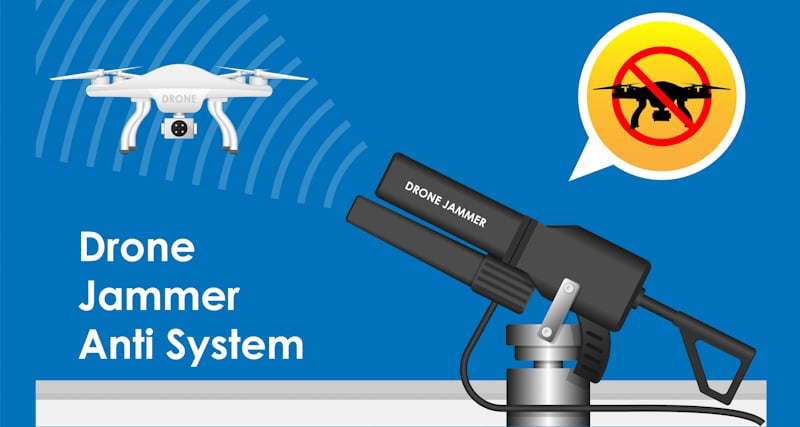Drone hobbyists and photography enthusiasts will agree that flying drones is both fun and entertaining. For first responder and commercial purposes, a drone is a valuable asset for information and productivity; however, when a drone is flying where it shouldn't, the potential aftermath can be explosive and, of course, costly. In situations such as these, you want to know how to detect a drone in the sky.
Detecting drones in the sky is possible with the use of different technologies that monitor drone activity in the airspace. However, each technology has different capabilities with regards to drone size and detection range.
Some of the methods of detection that we're going to discuss are RF technology, high-resolution radars, and visual tracking methods.
What Are The Uses Of Drones Or UAVs?
Unmanned Aerial Vehicles have multiple applications. They are used for many research purposes but are also widely used for spying or posing threats to the security of facilities.
They can be used as a threat to an airport, refineries, prisons, etc. People need ways to avoid these threats and keep their facilities secure from such activities. Therefore, multiple methods have been developed to detect drones in the sky to ensure security.
What is Drone Detection?
Drones are detected using various types of drone detection and tracking technology. Each of the different drone detection methods has its own capabilities regarding drone detection range and drone size. RF sensors are used to track drones operating on RF transmission, while radar detection is used for others that are Pre-Programmed to a GPS waypoint. In order to confirm a drone threat, visual drone detection methods like Pan, Tilt, and Zoom or PTZ cameras are used.
It is important to note that each type or method has its own set of advantages and disadvantages; therefore, you need to be fully aware of each method's limitations when it comes to detecting drone threats. For example, while some methods work irrespective of outside elements, other methods are suited to a specific environment. This is why using more than one method of drone detection is advised.
The Most Frequently Used Technologies for Drone Detection
High- Resolution Radars
High-resolution radars are designed specifically for detecting and tracking drones. They continuously scan the sky, looking for changes or reflections to detect movement and size. Mirrored signals are examined and contrasted to a knowledgebase for characterization of the drone. The collected signatures can, in turn, be used to eradicate non-drone-like objects in much the same way as radars are used to detect birds. The benefits of this signal preparation method are that it improves the performance of drone detection and leaves less room for minimal false positives.
Pros:
- Constant tracking
- Long-range
- Highly accurate localisation
- Independent of visual conditions
- Handles hundreds of targets simultaneously
Cons:
- Drone size affects detection range
- Needs transmission license and frequency check to prevent interference
- Usually cannot detect drones from birds
RF (Radio Frequency) Technology
The majority of drones today use the radio frequency spectrum to liaise with their pilots. Specific RFID chips are used to pair them together and to keep the receiver and transmitter connected, which manages other devices on the same frequency and ultimately reduces the risk of other factors overtaking the drone. This method makes use of radiofrequency sensors that monitor and listen to the 70 MHz to 6GHz frequencies passively. This is imperative for transmissions between the drone and the pilot(receiver) and ultimately determines the drone's location or the pilot's site as well.
Pros:
- Low cost
- No license required
- Detects and, in some cases, identifies multiple drones and controllers
Cons:
- Can't detect autonomous drones
- Can't always locate and track
- Not so effective in crowded RF areas
- Short-range
Visual Tracking Methods
Other detection technology is used with PTZ cameras to create and convey visible data of a drone incident. Therefore, the drone detection software usually prompts the drone's GPS location with the PTZ camera to allow the camera to Pan, Tilt, and Zoom in the proper region to record the drone's visuals. Due to external elements such as changes in season, or weather conditions, visual observation is not recommended as a suitable first line of defense when detecting a drone in the sky. However, when it comes to real-time and future review, it is a priceless tool for recording drone incidents.
Pros:
- Can record images as forensic evidence for use in the potential or eventual prosecution
- Provides visuals on the drone and its payload
Cons:
- High false positives
- Must be used in conjunction with another drone detection method
- Poor performance in fog, low-light etc
The Purpose of Detecting Drones in the Sky?
Currently, commercialized drones contain some attributes that make these unmanned flying devices a threat to organizations or companies like stadiums, gas refineries, airports, and prisons. Additionally, drones flying near a ramp pose a potential danger to aircraft during landing and takeoff. These unmanned aerial systems are potential threats to prisons, stadiums, and oil and gas due to their capacity to transport payloads and divert ground security.
So in light of this, security teams must have a system in place to expose drones so that they can ultimately take note of any potential threats resulting from these unmanned devices.
The good news is that there are diverse technologies, methods, and solutions to assist security teams in tracking drones. These solutions can be used to determine the drone's address as well as the location of the device, its speed and altitude, the category of drone they are dealing with, and the pilot's GPS location.
Ultimately, the most dependable drone detection method can ultimately adapt to the company's requirements by merging several equipment sensors in a single software interface.
How to Tell Which Drone Detection Method is Best for Me?
Determining the best drone detection technology for yourself or your facility depends on numerous factors. These factors include your budget, requirements, your security demands, and, more importantly, the layout of your facility.
Most of the drones are tracked using RF sensors because approximately 70% of drones on the market today liaise using the RF frequency. One of the reasons for its popularity is that RF sensors have a substantial observation area that is approximately 1 to 10 miles. This, however, depends on sensor specifications. They are also a more economical option for drone spotting.
Experts suggest that you begin with RF solutions to get an idea of the unmanned devices in your area, get factual statistics on the amount of drone flights, and identify vulnerable areas. Decisions regarding whether the company needs radar detection and which areas need visible exposure and RF detection can then be determined by security teams based on the insights they've gathered from actual real-time drone flight statistics.
Who Needs Drone Detection Solutions?
It would make sense that airports need to have drone spotting technology due to the fact that these aerial devices may run into planes that are either taking off or landing. The consequences of which will be dire. Due to the fact that these devices also transport payloads, it is crucial that they are monitored by prisons, stadiums, gas and oil plants as well as other critical infrastructure.
How Many Methods of Drone Detection Do I Need?
Every facility has its own set of drone spotting requirements. However, one of the factors that does play a role is the amount of RF interference currently being experienced due to the facility's layout and the environment. So the point is that if tall buildings currently envelop your facility, it will likely block some of the RF signals so, you'll probably need multiple RF sensors in order to accomplish adequate or competent drone detection. On the other hand, if your facility is based in an open field, you likely only require one RF sensor in order to get the job done.
Another point to note is that your company or facility may have either one or multiple RF blind spots, meaning you might need to also implement visual and radar methods to accomplish the desired outcome or level of detection.
The Layered Approach
The reality is that there is no single method or spotting technology that can do it all. Consequently, you need different technologies that are used concurrently with each other. This includes the information gathered from RF sensors that are merged into the sole software program in order to make it simpler to spot drones.
So basically, when it comes to layering detection tools, you'll need a way to get an eye on the spotted drones, and then you can layer PTZ cameras with RF detection. What this does is correspond to the GPS coordinates, which are transferred to them by the RF sensor.
If you discover unspotted flights that are undetected by the RF sensor, try to layer the visual sensors with RF sensors and radars installed in the most crucial areas.
Anti-Drone Equipment
When we refer to anti-drone equipment, we are simply referring to counter measuring or negating drones by either neutralizing the drone, physically destroying the drone, or taking full control of the drone. As this is the 21st century, and the technologies are readily available, it is still worth noting that federal regulations, in most countries, make the use of the following technologies illegal, especially when it comes to neutralizing drones. However, exceptions are obviously made for enforcement and military agencies.
RF Jammers
An RF jammer is basically a mobile, handheld, or static device which ultimately transfers a substantial amount of radiofrequency energy to the drone. This, in turn, masks the controller signal, and there is often one of four scenarios:
- Drone returns to the user-set home location
- Drone makes a controlled landing in its current position
- Drone falls uncontrolled to the ground
- Drone flies off in a random uncontrolled direction
Pros:
- Reasonable cost
- Non-kinetic neutralization
Cons:
- Can jam or affect other radio communications
- May result in unpredictable drone behavior
- May send the drone to its target, unintentionally
High Power Microwave Devices
HPM or high-power microwave devices give rise to an electromagnetic pulse or EMP. This pulse is skilled in placing electronic devices in disarray. The pulse then impedes radio links and may stop or even destroy the electronic circuitry in these unmanned aerial devices. Consequently, it also destroys other electronic devices that are within range. This is ultimately due to the current and damaging voltage that it creates. High power microwave devices can also involve an antenna that sends the electromagnetic pulses in a specific direction, thereby minimizing possible collateral damage.
Pros:
- Non-kinetic
- Within range, the drone can be effectively stopped
Cons:
- May disrupt communications
- High cost
- May cause drone to switch off and fall to the ground
GPS Spoofers
This is basically a device that sends a brand new communication to the UAS. The signal intercepts transmission with GPS satellites that the drone needs for navigation. As a result, the UAS is "spoofed" into thinking that it's somewhere else. The aerial device's mission is then controlled by forcefully launching the GPS coordinates instantaneously. So once the drone is being headed by the spoofing device, it can be lead to the safe zone.
Pros:
- Feasible
- Non-kinetic neutralization
Cons:
- Can block other radio transmissions
- Short-range
Nets and Net Guns
When you net a drone, you basically bring the net in contact with the drone and stop the drone by restricting the rotor blades. The three main types of nets and guns that restrict drone movement include:
Hanging net(disposed of a net drone: The result is that the drone is captured by moving the friendly net drone towards the rogue drone. So ultimately, what happens is that the friendly drone will either carry the rogue drone to a safe zone or, in the event that it's too heavy, release it without or with a parachute to assist in the managed fall of the unmanned aerial device.
Net cannon: It basically overrides the restricted scope of a net cannon on the ground. It's usually made use of with a parachute for managed sinking or falling of the unmanned device, but it can also be difficult to capture another moving drone.
Net cannon(fired from the ground): This can either be shoulder-launched, handheld or turret-mounted. It's effective anywhere from 20 to 300 m and can be used either without or with a parachute in order to control the descent of the drone.
Pros:
- Captures the drone physically
- Idea for forensics
- High-accuracy
- Semi-automatic
- Long-range
- Minimal risk of damage
Cons:
- The kinetic solution
- May result in debris hinging on parachute options used.
- Short-range on ground launched nets
The Benefits of Drones
Over the years, drones have tackled things like disease control.
Drones are intercepting everything from vacuuming up ocean waste and disease control to delivering pizza and everything in-between. Tech-savvy consumers and defense organizations have also used drone technology for a while; however, the fact is that the advantages of these unmanned devices extend far beyond these three factors.
Due to drones' increasing readiness, many people find that their high-paying and dangerous jobs, especially within the commercialized precinct, are at-risk of drone technology. In fact, drones can take on any role involving data collection or delivery.
However, if history has anything to say about it, the drone's capacity to perform escalating or complex tasks will soon be realized. According to PWC, the surfacing international market for business services uses drones to the value of $127 billion. Consequently, investment into the UAVs space has grown significantly as more corporations capitalize on these times.
Let's take a look at how drones have helped society and the world at large.
Defense
While most individuals know that drones have been used for more than ten years by the military, ground forces are regularly using smaller drones. Most of the drones are exclusively designed for surveillance; however, there are few that are designed for other military operations.
Emergency Response
Innovations in camera technology have significantly impacted the growing use of drones. Drones complete with thermal imaging cameras continue to provide emergency response teams with suitable solutions for identifying and locating victims who are hard to find using the normal line of sight.
Consequently, universities and startup companies alike are designing systems that are specifically for search and rescue operations. Most UAVs are designed to operate in restricted areas with impaired lines of sight, making them ideal for search and rescue missions.
Conservation
Two factors that have a substantial effect on the health of wildlife globally are poaching and climate change. In fact, it is predicted that thousands of different species will become extinct in the years to come, according to the World Wildlife Fund.
In an attempt to mitigate the circumstances, conservationists are imploying unique and advanced methods to study and protect our global ecosystems. It is believed that autonomous drones are being built to follow endangered species and then forward information about them back to their researchers.
These are just a few of the ways that drones have positively impacted society, and the list goes on.
Conclusion
Aside from providing individuals with hours of entertainment and offering benefits for various applications, a misused drone can create dangerous situations. In light of this, it is imperative for any important organization, facility or company to protect their information, clients and employees from possible drone attacks.
Shawn Manaher loves to play with new toys and dive into new hobbies. As a serial entrepreneur, work definitely comes first but there is always room for hobbies.

![How To Detect A Drone In The Sky [ANSWERED]](https://hobbynation.net/wp-content/uploads/2021/02/how-to-detect-a-drone-in-the-sky.jpg)



